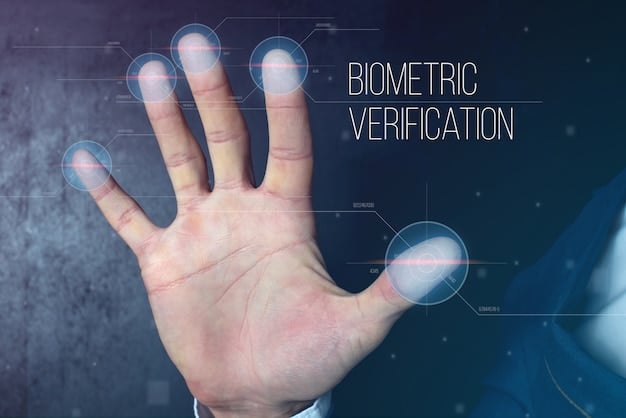Cybersecurity Essentials: Protect Your Career & Company

Cybersecurity essentials involve proactively implementing robust digital defenses, understanding evolving threats, and fostering a security-aware culture to safeguard both individual careers and organizational assets against sophisticated and persistent cyberattacks.
In today’s interconnected world, the digital landscape presents both unprecedented opportunities and significant risks. For professionals and organizations alike, understanding Cybersecurity Essentials: Protecting Your Career and Company from Evolving Threats is no longer just an IT department concern; it’s a fundamental requirement for survival and success. The pace of digital transformation continues to accelerate, bringing with it a proliferation of sophisticated cyber threats that can jeopardize careers, compromise sensitive data, and cripple entire enterprises.
The Escalating Cyber Threat Landscape
The digital realm is a double-edged sword, offering immense connectivity and innovation alongside an increasingly aggressive and complex threat environment. Cybersecurity is no longer a niche technical field but a broad discipline essential for every individual and organization navigating the modern economy. The threats are diverse, ranging from individual phishing attempts to large-scale state-sponsored cyber espionage, each with the potential for severe repercussions.
Understanding the current panorama of cyber threats is the first step in effective defense. It involves recognizing that attacks are not static; they evolve with technology, human behavior, and geopolitical dynamics. Staying current with these trends is paramount, not just for dedicated security teams, but for every employee who handles digital information, as they often represent the first line of defense.
Common Cyberattack Vectors
Cybercriminals employ a variety of methods to breach defenses. Knowledge of these common vectors empowers individuals and companies to build stronger, more resilient security postures. Many successful attacks exploit human vulnerabilities rather than purely technical ones, underscoring the need for comprehensive training and awareness.
- Phishing and Social Engineering: Deceptive tactics used to trick individuals into revealing sensitive information or performing actions that compromise security. This often involves fake emails, fraudulent websites, or impersonation.
- Malware (Viruses, Ransomware, Spyware): Malicious software designed to disrupt, damage, or gain unauthorized access to computer systems. Ransomware, in particular, encrypts data and demands payment for its release, posing a significant threat to business continuity.
- Insider Threats: Security risks originating from within an organization, either from malicious intent or accidental actions by employees, contractors, or partners.
- DDoS Attacks: Distributed Denial of Service attacks overwhelm systems with traffic, making them unavailable to legitimate users. While often disruptive, they can also serve as a smokescreen for other malicious activities.
The shift towards remote work and cloud computing has expanded the attack surface, creating new challenges for cybersecurity professionals. Securing geographically dispersed workforces and cloud infrastructure requires adapting traditional security models to accommodate these new paradigms.
Ultimately, a proactive approach to understanding and mitigating the cyber threat landscape is crucial. This means not just reacting to incidents but anticipating potential vulnerabilities and strengthening defenses before an attack occurs. Continuous vigilance and adaptation are key.
Building a Robust Personal Cybersecurity Posture
While organizational cybersecurity is critical, individual responsibility forms the bedrock of a secure digital ecosystem. Every professional, regardless of their role, has a part to play in safeguarding their digital presence, which in turn protects the wider company network. Personal cybersecurity extends beyond basic password hygiene to a holistic understanding of how personal digital choices impact professional security.
Developing strong personal cybersecurity habits means being vigilant about the information shared online, the applications used, and the links clicked. It’s about cultivating a mindset of skepticism towards unsolicited requests and recognizing the subtly of social engineering attempts. This personal fortress building provides a crucial first line of defense that complements broader organizational security measures.
Essential Practices for Digital Protection
Implementing a few core practices can significantly reduce your personal risk. These measures are often simple but highly effective, providing substantial returns on the effort invested. Neglecting these basics can render more sophisticated corporate defenses ineffective if an individual’s credentials are compromised.
- Strong, Unique Passwords and Multi-Factor Authentication (MFA): Avoid using easy-to-guess passwords or reusing them across multiple accounts. Implement MFA wherever possible, adding an extra layer of security beyond just a password.
- Regular Software Updates: Keep operating systems, applications, and anti-virus software updated. Updates often include critical security patches that fix known vulnerabilities exploited by attackers.
- Awareness of Phishing and Social Engineering: Learn to identify suspicious emails, texts, and calls. Never click on unverified links or open attachments from unknown senders. Always independently verify requests for sensitive information.
- Secure Wi-Fi Usage: Be cautious when connecting to public Wi-Fi networks, which are often unsecured. Use a Virtual Private Network (VPN) for added protection when accessing sensitive information on public networks.
Understanding data privacy and how personal information is collected, stored, and used online is also a critical component of personal cybersecurity. Being mindful of your digital footprint and the privacy settings on various platforms can significantly reduce exposure to targeted attacks and identity theft.
Furthermore, regular backups of important personal and work-related data ensure that even in the event of a ransomware attack or data loss, recovery is possible. This combination of proactive defense, vigilant awareness, and a robust recovery plan solidifies an individual’s personal cybersecurity posture, creating a more secure professional environment.

Organizational Cybersecurity Frameworks and Best Practices
For companies, navigating the complex cybersecurity landscape demands more than just individual vigilance; it requires a structured, multi-layered approach. Implementing robust organizational cybersecurity frameworks and adhering to best practices are paramount to protecting company assets, intellectual property, and customer trust. These frameworks provide a systematic way to manage cyber risk, ensuring that security measures are comprehensive, proportionate, and continuously evolving.
At its core, organizational cybersecurity is about identifying, assessing, and mitigating risks across the entire digital infrastructure. This encompasses everything from network security and data encryption to employee training and incident response planning. A mature cybersecurity strategy integrates these elements into a cohesive defense mechanism, rather than treating them as isolated components. It’s a continuous cycle of improvement, adapting to new threats and technological advancements.
Key Pillars of Corporate Cyber Defense
Effective corporate cybersecurity relies on several foundational pillars, each addressing a critical aspect of digital protection. Neglecting any one of these can create a vulnerability that attackers may exploit, emphasizing the need for comprehensive coverage.
- Risk Management and Assessment: Regularly identify potential threats and vulnerabilities to critical assets. Prioritize risks based on their potential impact and likelihood, guiding where security resources should be allocated.
- Incident Response Planning: Develop and regularly test a clear plan for what to do before, during, and after a security breach. This includes detection, containment, eradication, recovery, and post-incident analysis.
- Employee Training and Awareness: Human error remains a leading cause of security incidents. Continuous education on phishing, data handling, and company policies is crucial to building a human firewall.
- Network and Endpoint Security: Deploy firewalls, intrusion detection/prevention systems (IDS/IPS), and endpoint protection (antivirus, EDR) to secure network perimeters and individual devices.
- Data Encryption and Access Control: Encrypt sensitive data both at rest and in transit. Implement least privilege access, ensuring employees only have access to the information and systems necessary for their roles.
Adopting established cybersecurity frameworks like NIST (National Institute of Standards and Technology) or ISO 27001 can provide a structured roadmap for organizations to build and improve their security posture. These frameworks offer guidelines for managing security risks, implementing controls, and achieving compliance with various regulatory requirements.
Beyond technology, fostering a culture of cybersecurity within the organization is fundamental. This means integrating security considerations into all business processes, from product development to supply chain management. Leadership commitment and active participation are key to embedding this culture, ensuring that cybersecurity is seen not just as a cost, but as an integral investment in the company’s resilience and future success.
The Human Element: Cultivating a Cyber-Aware Workforce
Even the most advanced technological defenses can be undermined by human error or a lack of awareness. The “human firewall” is arguably the most critical component of any cybersecurity strategy. Cultivating a cyber-aware workforce means empowering every employee with the knowledge, skills, and vigilance needed to identify and thwart potential threats. It moves beyond mere compliance training to foster a proactive security mindset where employees understand their role in protecting the organization’s digital assets.
This goes beyond simply telling employees not to click on suspicious links. It involves explaining the “why” behind security policies, demonstrating the real-world impact of breaches, and regular reinforcement through engaging and relevant training. A well-informed workforce is less likely to fall victim to social engineering attacks and more likely to report suspicious activities, turning potential vulnerabilities into early warnings.
Strategies for Enhanced Employee Awareness
Effective cybersecurity awareness programs are not one-off events; they are continuous, adaptive endeavors that reflect the evolving threat landscape. They integrate various learning methods to ensure messages resonate with different roles and learning styles.
- Regular and Engaging Training Sessions: Move beyond annual compliance videos. Implement interactive workshops, mock phishing exercises, and real-life scenario discussions that highlight current threats.
- Clear Communication of Policies: Ensure all cybersecurity policies are easily accessible, understandable, and regularly reviewed. Employees should know what is expected of them regarding data handling, password management, and reporting security concerns.
- Simulated Phishing Attacks: Periodically conduct simulated phishing campaigns to test employee vigilance and provide constructive feedback. This helps identify areas for further training and reinforces cautious behavior without real-world consequences.
- Encourage Reporting: Create a culture where employees feel comfortable and empowered to report unusual or suspicious activity without fear of reprimand. Establish clear, easy-to-use channels for reporting.
Leadership plays a vital role in demonstrating commitment to cybersecurity awareness. When senior management actively participates in training and champions security best practices, it sends a powerful message throughout the organization. This top-down approach reinforces the importance of cybersecurity as a collective responsibility.
Ultimately, a cyber-aware workforce is a resilient workforce. By investing in continuous education and fostering a culture of vigilance, organizations transform their employees from potential weak links into robust defenders, significantly enhancing their overall cybersecurity posture and reducing the likelihood of successful breaches.
The Role of Compliance and Regulations in Cyber Defense
In an increasingly regulated world, cybersecurity is not just a matter of best practice but often a legal and ethical imperative. Compliance with various industry-specific and general data protection regulations plays a critical role in shaping an organization’s cyber defense strategy. These regulations, such as GDPR (General Data Protection Regulation), HIPAA (Health Insurance Portability and Accountability Act), and CCPA (California Consumer Privacy Act), impose stringent requirements on how organizations collect, store, process, and protect sensitive data.
Adhering to these regulations helps an organization demonstrate due diligence in data protection, building trust with customers, partners, and regulators. Non-compliance can lead to severe penalties, including hefty fines, reputational damage, and legal action, underscoring the urgency of integrating regulatory requirements into the core of cybersecurity initiatives.
Key Regulatory Considerations
Understanding the specific regulations pertinent to an organization’s industry and geographic location is the first step toward achieving compliance. Each regulation may have unique requirements concerning data handling, breach notification, and privacy rights.
- Data Privacy Regulations (e.g., GDPR, CCPA): Focus on protecting personal data, granting individuals greater control over their information, and mandating transparent data handling practices. This impacts how companies collect, store, and share customer and employee data.
- Industry-Specific Regulations (e.g., HIPAA for healthcare, PCI DSS for payment cards): Impose strict security standards tailored to the unique risks and data types within specific sectors. Non-compliance in these areas can have direct financial and operational consequences.
- Breach Notification Laws: Many regulations require organizations to report data breaches to affected individuals and regulatory authorities within specific timeframes. Failure to comply can result in significant penalties and loss of public trust.
- Record Keeping and Auditing: Organizations are often required to maintain detailed records of their security practices and demonstrate compliance through regular audits. This necessitates robust documentation and a clear audit trail of security controls.
Achieving compliance is not a one-time event but an ongoing process that requires continuous monitoring, updates to policies and procedures, and internal audits. It involves mapping organizational data flows, identifying where sensitive data resides, and implementing controls that align with regulatory mandates.
Ultimately, compliance should not be viewed merely as a burden but as a framework that strengthens overall cybersecurity posture. By designing security measures that satisfy regulatory requirements, companies inherently build more resilient and trustworthy digital environments. This proactive approach helps mitigate legal risks and enhances their credibility in the marketplace.
Future-Proofing Your Career with Cybersecurity Skills
As cyber threats continue to evolve, so does the demand for skilled cybersecurity professionals across all industries. Integrating cybersecurity awareness and, for many, specialized skills into one’s professional toolkit is no longer optional—it’s a critical component of future-proofing a career. Regardless of your primary domain, a fundamental understanding of cybersecurity principles enhances your value to any organization and opens doors to new opportunities in a rapidly expanding field.
The cybersecurity job market is experiencing significant growth, with a persistent skills gap globally. This means professionals with even foundational cybersecurity knowledge are becoming increasingly sought after. For those looking to specialize, advanced certifications and continuous learning are key to staying competitive and relevant as technology and threat actors advance their capabilities.
Pathways to Cybersecurity Proficiency
There are multiple avenues for individuals to enhance their cybersecurity acumen, from informal online learning to formal certifications demonstrating specialized expertise. The best approach depends on existing responsibilities, career goals, and desired depth of knowledge.
- Foundational Awareness for All: Every employee can benefit from understanding basic cybersecurity principles, recognizing common threats like phishing, and practicing good digital hygiene. This enhances personal security and contributes to organizational resilience.
- Upskilling in Current Roles: Many roles can be augmented by specific cybersecurity knowledge. For example, a developer understanding secure coding practices, or a sales professional recognizing data privacy implications, adds significant value.
- Specialized Certifications: For those pursuing dedicated cybersecurity careers, certifications like CompTIA Security+, Certified Information Systems Security Professional (CISSP), or Certified Ethical Hacker (CEH) provide recognized credentials validating expertise.
- Continuous Learning and Adaptation: The cybersecurity landscape changes rapidly. Staying current with industry news, attending webinars, participating in professional communities, and engaging in continuous self-study are essential for sustained relevance.
Emphasizing cybersecurity skills on a resume not only caters to a specific job market demand but also signals to potential employers a proactive and responsible approach to digital challenges. It indicates an understanding of the critical role security plays in business operations and reputation management.
Beyond technical skills, soft skills like critical thinking, problem-solving, communication, and adaptability are highly valued in cybersecurity. The ability to analyze complex situations, articulate risks clearly, and respond effectively to evolving challenges defines a valuable cybersecurity professional. Investing in these combined areas ensures a career pathway that is both resilient and highly rewarding in the coming years.

Responding to a Cyber Incident: Steps for Individuals and Companies
Despite the most robust preventative measures, cyber incidents can still occur. How an individual or an organization responds to a breach or an attack can significantly determine its ultimate impact. A swift, coordinated, and effective response minimizes damage, accelerates recovery, and helps maintain trust. Having a predefined incident response plan is crucial, as the moments immediately following a detection are critical for containment and investigation.
For individuals, this means knowing whom to contact and what immediate steps to take if personal data is compromised or if suspicious activity is observed. For companies, it involves activating a broader, multi-departmental plan, ensuring legal, IT, communications, and executive teams are all working in concert. The goal is not just to fix the technical issue but to manage the reputational and legal fallout effectively.
Individual and Corporate Incident Response
While the scale of response differs, the core principles of rapid detection, containment, and recovery are universal. Every second counts in a cyber incident, making preparedness key.
- Immediate Action (Individual): If you suspect a personal device is compromised (e.g., strange pop-ups, unusual account activity), immediately disconnect from the internet. Change passwords on affected accounts (use a different, secure device if possible) and notify relevant parties (e.g., bank, credit card company).
- Company Incident Response Team (IRT) Activation: For organizations, a designated IRT should be immediately notified. This team, comprising IT, legal, HR, and communications, will lead the response according to a predefined plan.
- Containment: The primary goal is to isolate the affected systems or networks to prevent further spread of the attack. This might involve shutting down systems, segregating networks, or disabling affected user accounts.
- Eradication and Recovery: Once contained, the threat needs to be removed from all affected systems. This is followed by restoring systems from secure backups, patching vulnerabilities, and verifying the integrity of the environment before bringing it back online.
- Post-Incident Analysis: Learning from the incident is vital. A thorough review should identify the root cause, assess the effectiveness of the response, and identify areas for improvement in security controls and incident handling processes.
- Communication (Individual & Corporate): Individuals should be aware of who to contact within their organization (e.g., IT Security team) if they observe suspicious activity. For companies, transparent and timely communication with affected parties (customers, employees, regulators, media) is crucial, balanced with legal and investigative considerations.
Practicing incident response through drills and simulations is just as important as having a plan. These exercises help identify weaknesses in the plan, train personnel, and ensure a smooth, coordinated reaction when a real incident occurs. A well-rehearsed response minimizes chaos and maximizes the chances of a swift and successful recovery, protecting both careers and company assets in the face of evolving cyber threats.
| Key Point | Brief Description |
|---|---|
| 🛡️ Evolving Threats | Cyberattacks are becoming more sophisticated, necessitating continuous learning and adaptation for defense. |
| 👨💻 Personal Security | Strong passwords, MFA, and phishing awareness are vital for individual and collective protection. |
| 🏢 Corporate Frameworks | Organizations need structured risk management, incident response, and strong network security. |
| 🎓 Future-Proof Skills | Acquiring cybersecurity knowledge is crucial for career relevance and growth across all sectors. |
Frequently Asked Questions About Cybersecurity Essentials
Cybersecurity is essential for everyone because nearly all professional roles now involve digital interactions and data handling. Every individual’s digital habits, from password practices to identifying phishing attempts, directly impact an organization’s overall security posture. A single weak link can compromise entire systems, making universal awareness critical for collective protection.
Individuals primarily face threats like phishing attacks, which trick users into revealing sensitive information; various forms of malware, including ransomware that locks data; and identity theft, where personal information is stolen for malicious purposes. Social engineering tactics, often combined with phishing, are also prevalent, exploiting human psychology rather than technical vulnerabilities.
Strong, unique passwords make it harder for attackers to guess or crack your credentials. MFA adds a crucial second layer of verification, often through a code sent to your phone or a biometric scan. Even if your password is stolen, without that second factor, unauthorized access is significantly prevented, making your accounts far more secure against breaches.
Regular software updates are vital because they often include critical security patches that fix vulnerabilities discovered by developers. These vulnerabilities, if left unaddressed, can be exploited by attackers to gain unauthorized access, install malware, or compromise systems. Keeping software updated ensures you benefit from the latest protections against known threats.
Knowing how to respond to a cyber incident, both individually and corporately, is important because swift and decisive action can dramatically minimize damage. A well-practiced incident response plan helps contain the breach, recover compromised data, and maintain trust with stakeholders. It transforms a potential crisis into a manageable event with quicker, more effective resolution.
Conclusion
The journey toward mastering Cybersecurity Essentials: Protecting Your Career and Company from Evolving Threats is an ongoing one, marked by continuous learning, adaptation, and a proactive mindset. In a world increasingly defined by digital interactions, strong cybersecurity is no longer a luxury but a fundamental necessity for both individual professional resilience and organizational integrity. By understanding the evolving threat landscape, cultivating robust personal security habits, implementing comprehensive organizational frameworks, and fostering a cyber-aware workforce, we can collectively build a more secure digital future. Embracing these essentials not only safeguards valuable assets and careers but also underpins trust and sustains innovation in the face of persistent cyber challenges.





